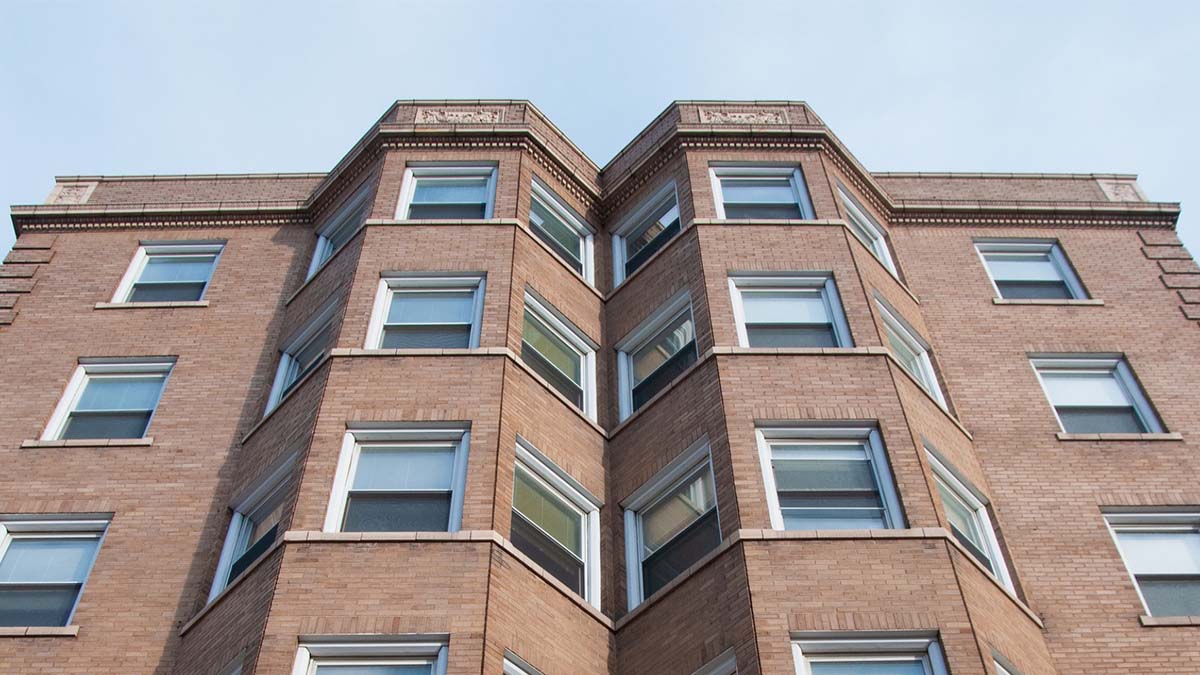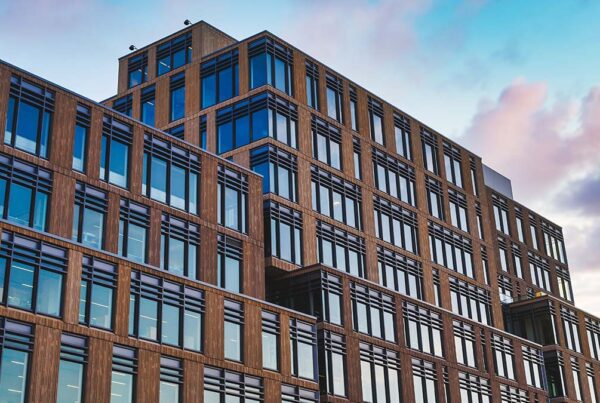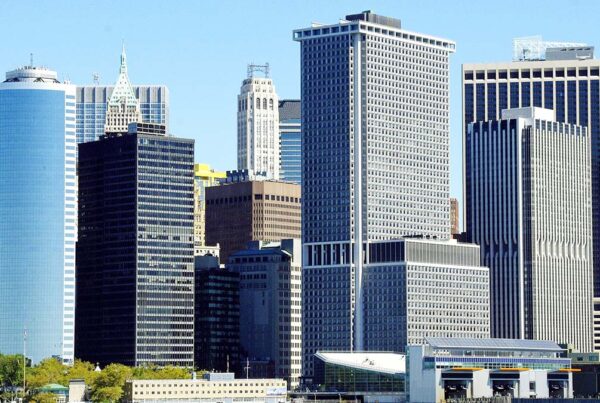
Multifamily real estate is one of many different types of real estate and consists of properties that contains more than one liveable unit so that multiple tenants can live separately under the same roof.
This means multifamily real estate includes everything from duplexes to 500+ unit apartment buildings.
However, there’s a slight distinction between residential multifamily real estate and commercial multifamily real estate.
What is the Difference Between Residential and Commercial Multifamily Real Estate?
Multifamily real estate that contains four or fewer units, such as duplexes, triplexes, and fourplexes, is considered residential real estate. Because of this, residential multifamily is frequently referred to as “small multifamily.”
Commercial multifamily real estate is residential real estate with five or more units.
You can approach both residential and commercial multifamily real estate the same way. The largest difference is simply in the way that you fund them. For residential multifamily real estate, you can acquire a conventional loan and even use products like FHA or VA loans. For commercial multifamily real estate, you must secure a commercial real estate loan.
While the largest difference between the two is the types of funding you can use, commercial multifamily real estate has one big advantage over residential multifamily real estate.
What is the Biggest Advantage of Investing in Commercial Multifamily Real Estate?
Compared to residential multifamily investments, the most significant advantage of commercial multifamily investments is the component of scale.
If you own a single-family house and the tenant decides to leave, you now have a 100% vacancy rate, and all of your income disappears until you fill the property with a new tenant. A few months of 100% vacancy has the potential to decrease your reserves and hurt your financial situation significantly.
If you own a triplex (which is classified as a residential multifamily property), and one of the three tenants decides to leave, you now have a 33% vacancy rate. While a 33% vacancy rate is still high and decreases your monthly revenue, it’s a softer hit than a 100% vacancy rate because most of your income is still coming in every month.
These two examples show that scale is an essential factor even with residential multifamily real estate or “small multifamily” properties.
The beauty of commercial multifamily investment properties is that the larger you go, the more favorable your vacancy rates become.
For example, if you have a 50-unit apartment building and ten tenants decide to leave, you only have a vacancy rate of 20%.
If you have a 200-unit apartment building and twenty people decide to leave, you only have a vacancy rate of 10%.
Additionally, you could stagger leases to begin and end at different times to further mitigate your vacancy rates. Doing this reduces the number of tenants who could leave during any given period and makes your cash flow more stable.
Despite being more expensive and requiring more debt, larger commercial multifamily properties can often be considered “safer” investments than properties with fewer tenants when done right.
What Are the Types of Multifamily Real Estate?
There are six types of multifamily real estate. The six types of multifamily real estate include Small Multifamily, Garden Apartments, Low-Rise Apartments, Mid-Rise Apartments, High-Rise Apartments, and Special-Purpose Multifamily Real Estate.
Here’s an overview of each type of multifamily real estate.
1. What is Small Multifamily Real Estate?
Small multifamily real estate includes duplexes, triplexes, and quadplexes with two, three, and four-unit properties, respectively. Since these properties are the smallest type of multifamily real estate, they often have more of an “independent” feel. Each of these units usually has its own entrances, appliances, and HVAC systems. Many units even have their own garages.
You can find small multifamily properties in most cities around the United States because they’re a practical and affordable type of housing for all city sizes.
The National Multifamily Housing Council shows that approximately 17% of renters live in a small multifamily property.
2. What Are Garden Apartments?
Garden-style apartments are apartment buildings grouped in an outdoor-style complex. Each building typically has one to three floors, and the complex property usually has a garden-like setting such as vast lawns, trees, and other landscaping between the buildings.
Units within garden apartment buildings are usually studio, one-, two-, and three-bedroom apartments. Tenants who live in the complex often share access to community amenities like playgrounds, laundry rooms, fitness centers, pools, dog parks, and more.
In summary, Garden Apartments are a collection of low-rise apartment buildings in one complex that share green space and amenities.
3. What Are Low-Rise Apartments?
A low-rise apartment building has four or fewer floors.
These apartments are often “walk-up” apartments. Walk-up apartments are apartment buildings that have a few floors without an elevator so you are required to walk up the stairs to get to your unit.
Some low-rise apartments have a shared laundry area if the individual units don’t have laundry machines. Low-rise apartments can be a single building or grouped into a complex such as Garden Apartments.
4. What Are Mid-Rise Apartments?
Freddie Mac defines mid-rise apartment buildings by having five to twelve floors. Mid-rise apartments typically have elevators and are usually closer to the urban core where housing demands are higher.
Mid-rise apartments usually have 30–110 units and are generally located in areas where tenants can walk to nearby stores, restaurants, office real estate, and public transportation.
5. What Are High-Rise Apartments?
Freddie Mac defines high-rise apartments as multifamily buildings that have nine or more floors. High-rise apartments are usually found in larger markets to support large populations, have more than 100 units, and are typically managed professionally.
High-rise apartment buildings tend to provide several amenities to service a high number of tenants. Amenities can include front desk service, elevator service, garage parking, laundry rooms, gyms, office spaces, rooftop pools, community kitchens, and more.
Like mid-rise apartments, the walkability factor is often an important factor for high-rise apartments.
If the high-rise apartment building exceeds 40 stories and meets the city’s height requirements, it can be considered a skyscraper.
6. What is Special Purpose Multifamily Real Estate?
Special Purpose Multifamily is a multifamily property of any style that targets a particular population segment.
The most common population segments for special purpose multifamily are:
- Student Housing: Student housing provides housing to college and university students. Because of this, student housing is always located close to a school campus. At least half of the units in the building must be for students attending a nearby learning institution to be classified as student housing.
- Seniors Housing: Senior housing or assisted living properties are properties designed to support senior citizens. These special purpose properties often provide their tenants with more support than other types of multifamily properties to help with their age-related needs.
- Subsidized Housing: Subsidized housing is for low income or special needs tenants and is designed to be affordable via rent and income restrictions. Subsidized housing is also supported by government programs such as Section Eight.
Now that you know each type of multifamily housing, let’s look at the different types of multifamily real estate asset classes.
What Are The Multifamily Real Estate Asset Classes?
Multifamily properties are mainly evaluated based on their location, age, condition, amenities, and rental income. To simplify a property with these main criteria, multifamily properties are categorized by an asset class.
Multifamily real estate has four classes: A, B, C, and D. As a commercial real estate investor, it’s critical that you understand each real estate asset class.
Here’s an overview of each multifamily class:
Class A Multifamily Real Estate
- Consists of the newest and most luxurious apartment buildings
- Typically built within the last ten years
- Located in popular and desirable areas
- Demand the highest rental prices per door
- Have lower cap rates than other multifamily real estate asset classes
- Usually purchased by investors for appreciation
Class B Multifamily Real Estate
- Consists of nice apartment buildings in good condition
- Typically built within the last 15–20 years
- Located in popular and desirable areas
- Demand the second-highest rental prices per door
- Have a cap rate between Class A and C apartments
- Usually purchased by investors for appreciation
Class C Multifamily Real Estate
- Consist of older apartment buildings that need updating
- Typically over 30 years old
- Located in areas less-desirable areas than Class A and B apartments
- Incur below-market rents
- Require higher CAPEX costs
- Generally provide good cash flow
- Usually purchased by investors for a value-add strategy to force appreciation
Class D Multifamily Real Estate
- Consist of older, run down apartment buildings
- Typically over 40 years old
- Often located in high-crime areas
- Incur below-market rents
- Regularly experience high vacancies
- Tends to be the most challenging asset class to manage
Multifamily Real Estate Summary
This is a lot of information to digest in one sitting, but it will become second nature to you the more you study it, analyze deals, and invest. Here’s a high-level summary of what we covered in this article:
- Multifamily real estate is real estate that contains more than one unit so that multiple tenants can live separately under the same roof.
- Multifamily real estate includes everything from duplexs to 500+ unit apartment buildings.
- There’s a slight distinction between residential multifamily real estate and commercial multifamily real estate.
- Residential mutlifamily real estate contains four or fewer units and can be funded with conventional loans.
- Commercial multifamily real estate contains five or more units and can be funded with commercial real estate loans.
- There are six types of multifamily real estate:
- Small Multifamily
- Garden-Level Multifamily
- Low-Rise Apartments
- Mid-Rise Apartments
- High-Rise Apartments
- Special Purpose Multifamily
- Every type of multifamily real estate is classified by classes A, B, C, and D



